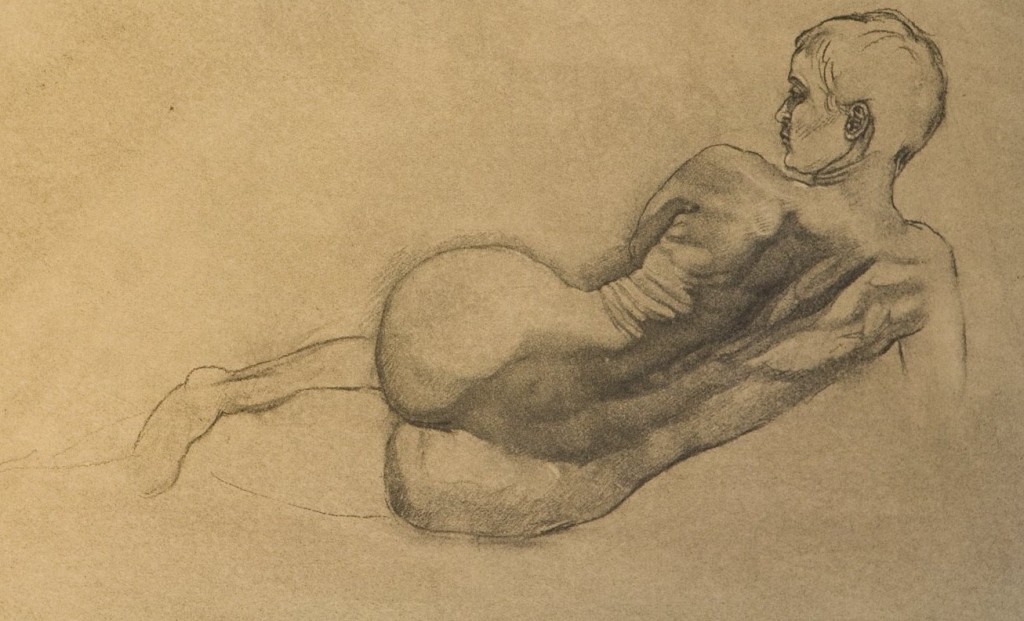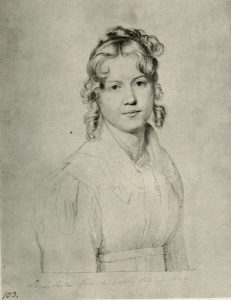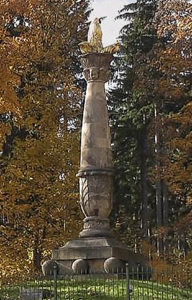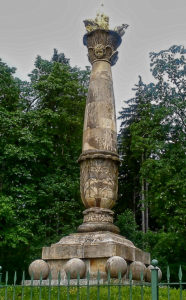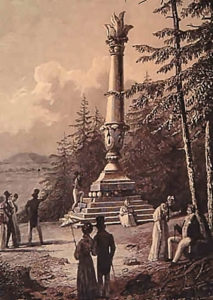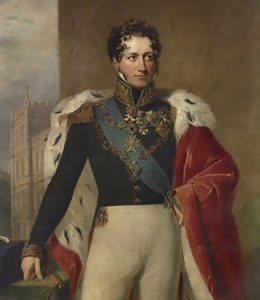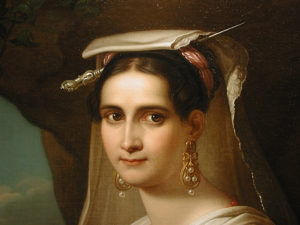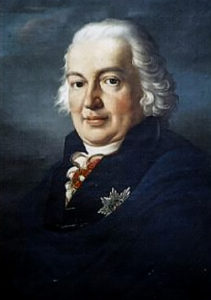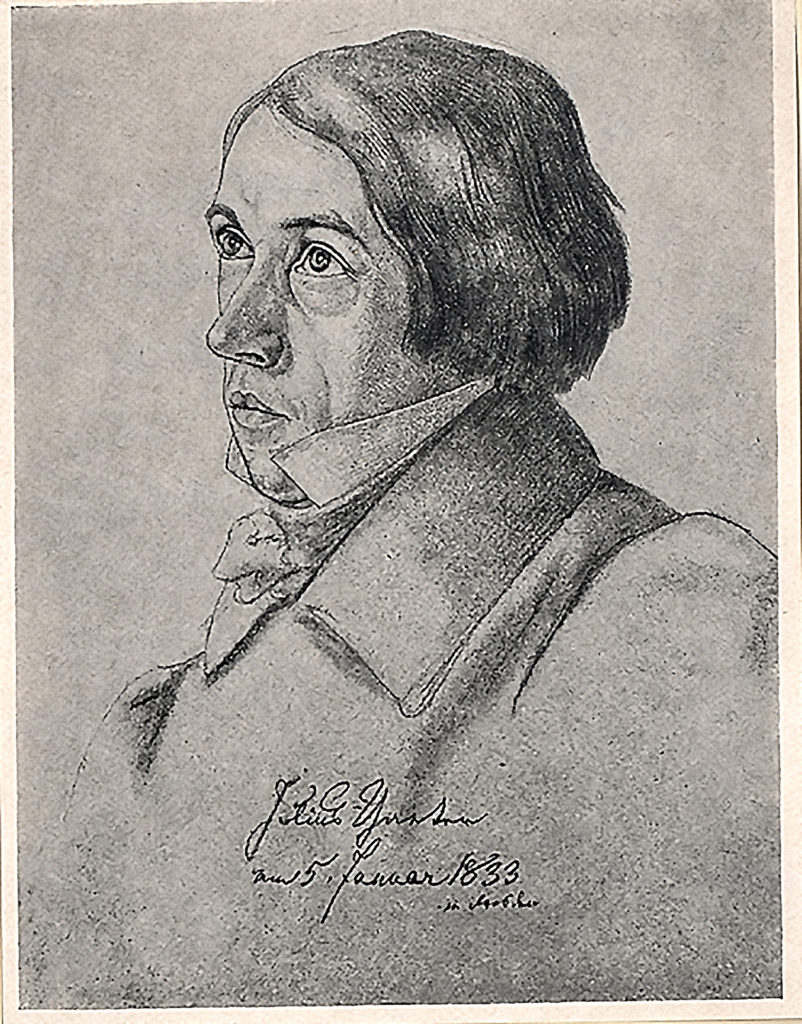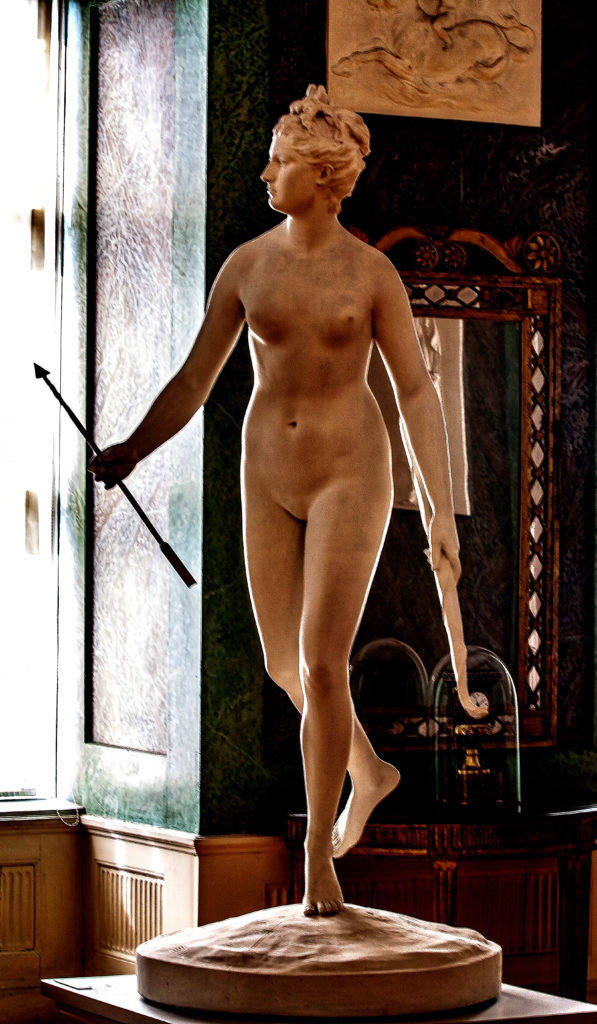Gotha, Friedrich W. E. Döll, sculptor, Vielsdorf, Thuringia 1750–1816
Gotha, Friedrich W. E. Döll, sculptor, Vielsdorf, Thuringia 1750–1816
Gotha, Friedrich W. E. Döll, sculptor, Vielsdorf, Thuringia 1750–1816 Gotha, Weimar, Jena, Classicism in 18th. and 19th. Century Sculpture
Friedrich Wilhelm Eugen Döll, (1750, Veilsdorf bei Hildurghausen – 1816, Gotha) was a German sculptor. In the sphere of Eugen Doel was Louise Seidler born on 15 May 1786 was the daughter of an academic in the university in Jena. She spent her youth with her grandmother (under whom she learned music and drawing) then on her grandmother’s death was adopted by the wife of a doctor Stieler at Gotha. Her love of art was developed under the sculptor Friedrich Wilhelm Eugen Döll, (Doell) who had returned to Gotha after an eleven-year stay in Rome. Back in Jena she lived in her father’s house, next door to Goethe’s home in Jena’s Schloss, getting to know him – Goethe, in her childhood. In Jena she also became friends with Silvie von Ziegesar and Pauline Gotter, later wife of the Jena professor Friedrich Wilhelm Schelling. Louise Seidler gained full admission to intellectual circles in the city, which then included Friedrich Schiller, Johann Gottlieb Fichte, Friedrich Wilhelm Schelling , Georg Wilhelm Friedrich Hegel, the brothers Alexander and Wilhelm von Humboldt, the brothers Friedrich and August Wilhelm Schlegel, Friedrich Tieck, Clemens Brentano, Voß, Paulus, Friedrich Immanuel Niethammer, Zacharias Werner and others. Goethe met her in the house of the publisher Carl Friedrich Ernst Frommann, and had a lifelong close friendship. The Gothaer Hofbildhauer Eugen Friedrich Wilhelm Doell (1750 – 1816) founded 1786 at the palace Friedenstein of Ernst II, in Gotha, Thuringen, Germany an Academy of Fine Art, and an Abgusssammlung, (plaster cast collection of primarily antique Greek Hellenistic and Greco-Roman copies of the Hellenistic sculpture). Doell created the marble bust of Johan Joachim Winckelmann in Rome in 1779-1780. After he studied initially with Ney in Fulda, he also studied with Jean Antoine Houdon in Paris from 1770 to 1773. This earlier study of Doell and his Rome venture was supported with a paid stipend to study with Raphael Mengs and Johann Friederich Reiffenstein, and to make copies of Greek sculpture in Italy for eleven years, as well as his achievements after returning to Gotha by Ernest Frederick, Duke of Saxe-Coburg-Saalfeld, Ernest Frederick’s son Francis, Franz Friedrich Anton Duke of Saxe-Coburg-Saalfeld (Francis, Duke of Saxe-Coburg-Saalfeld – Coburg, 15 July 1750 – Coburg, 9 December 1806. He was the eldest son of Ernest Frederick, Duke of Saxe-Coburg-Saalfeld and Sophia Antonia of Brunswick-Wolfenbüttel. He received a private, careful and comprehensive education and became an art connoisseur. Francis initiated a major collection of books and illustrations for the duchy in 1775, this despite his inheriting a near ruined duchy. Franz Frederick Anton collected engravings of significant artists between the 15th and 18th century which eventually expanded to a 300,000 picture collection of copperplate engravings currently housed in the Veste Coburg. He was commissioned into the allied army in 1793 when his country was invaded by the Revolutionary armies of France. The allied forces included Hanoverians, Hessians, and the British. He fought in several actions against the French. Francis succeeded his father as reigning Duke of Saxe-Coburg-Saalfeld in 1800. In the discharge of his father’s debts the Schloss Rosenau had passed out of the family but in 1805 he bought back the property as a summer residence for the ducal family. Emperor Francis II dissolved the Holy Roman Empire on 6 August 1806, after its defeat by Napoleon at the Battle of Austerlitz. Duke Francis died 9 December 1806. On 15 December 1806, Saxe-Coburg-Saalfeld, along with the other Ernestine duchies, entered the Confederation of the Rhine as the Duke and his ministers planned). Doell’s support continued with Duke Ernst Anton Carl Ludwig I of Gotha, and Altenburg, Thuringen (Coburg, 2 January 1784 – Gotha, 29 January 1844) He had previously been Duke of Saxe-Coburg-Saalfeld (as Ernst III) from 1806 until the duchy was reorganized in 1826. When Ernst (Ernst Anton Carl Ludwig) succeeded his father in 1806, Duke Ernst III’s country – Saxe-Coburg-Saalfeld – was under French control. Ernst already had to fight against Napoléon as a general of the Prussians. The peace of Tilsit in 1807 enabled the young duke to get back his territories, having the Russians on his side. His sister Juliane was married to Konstantin, the brother of Alexander I Tsar of Russia. After the Congress of Vienna and its hence resulting gain of territory which Ernst should sell to Prussia years later, he could achieve Gotha that belonged to the territory of his former wife. Now he became Duke of Saxe-Coburg and Gotha. He proved to be a patron of arts and sciences and the first German sovereign to rebuild castles in a romantic neo-Gothic style, embedded in parks of British landscape style. His younger brother Leopold (Georg Christian Friedrich) was later elected the first King of the Belgians. This support in extensive education from the top artists of Doell’s time, as well as an amazing amount of time sculpting directly from the best Greek and Greco-Roman sculpture, achieved a level of sculpture greater than the Germanic school was able to offer at the time. On his return, he was appointed court sculptor in 1784 and received commissions for busts, monuments, and reliefs, particularly for the residences at Gotha, Anhalt-Dessau and Meiningen. In 1786 he became a professor (his own pupils included the painter Louise Seidler) and in 1787 was put in charge of art monuments in Gotha. The program was no doubt influenced by Houdon. The largest collection of Houdon’s sculpture work was in Gotha, Germany, collected by Ernst Duke of Saxony-Gotha, and Altenburg. The collection in Gotha rivals the collection in the Louvre of Houdon’s sculpture. Houdon’s sculpture was collected and commissioned in his lifetime in Gotha, Berlin, Weimar, Eisenach, Altenburg, Rudolstadt, and Schwerin, Germany.
Schillers_Gartenhaus_in_Jena_1797
Schiller’s garden house in Jena. 1797; Sitting from left: unknown, Caroline von Beulwitz, Charlotte Schiller with son Karl, Herder, unknown, Caroline von Dachroeden and others, Schiller; Standing from the left: Geothe, Wieland, Wilhelm and Alexander von Humboldt.
After the negative reply, Goethe advised me to buy the garden house of the late court councilor, Schmidt, who, because of its proximity to the city, excellently suited himself. I did not possess the required 1,200 thalers, but I did not want to give up the plan, for the house lay in a charming, beautiful setting with a splendid view, and had every conceivable advantage. So convinced of my plans, I wrote to Cotta and asked him for a corresponding advance, since I could not have lent the money elsewhere. My mother-in-law had laid all the money and could not dispose of it freely.
Cotta helped, and I was able to conclude the purchase contract on 16 March 1797. The spacious house was situated south-west of Jena’s market square, between the Angel Gate and Neutor, on a canyon through which a part of the Leutrabache stretches around the city.
[]
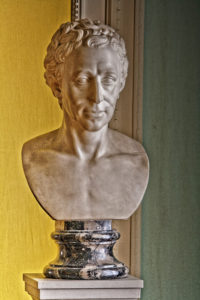
Frederich Wilhelm Eugen Doell, sculpture portrait bust of Johann Joachim Winckelmann, Friedenstein Castle, Schloss Friedenstein, Gotha, Thüringen
Frederich Wilhelm Eugen Doell, Minerva handing Pegasus over to Bellerophon, marble relief, Gotha, Thüringen, Germany





















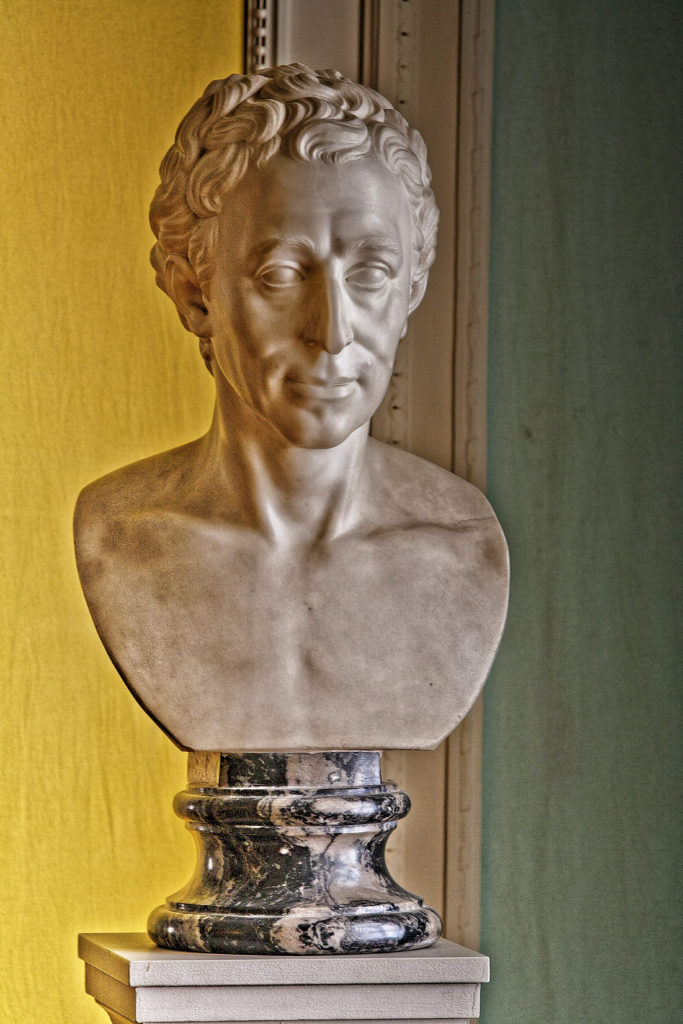
Doells marble bust, H 48.2 cms, fas 446
Johann Joachim Winckelmann (1717-1768) lived since 1755 he lived Rome where a scholarship of the Dresden health resort prince allowed to him an independent scholar’s life. Later he became a librarian in the service of the cardinal Archinto and he reached in narrow touch with the Roman scholar’s world. After the death Archintos he began in 1759 as a librarian with the cardinal Alessandro Albani, the biggest antique collector in Rome in whose services he remained up to his death. In April, 1763 nightmare aniseed the office of an upper supervisor of all antiquities in and around Rome was transmitted to him by the mediation. In spring, 1768 he began a long planned trip to Germany which he exited, however, already in Regensburg and returned over Vienna to Italy. In Trieste he fell victim to a murder with robbery. Today Winckelmann becomes as‚ father ’ of the classical archeology designated. On many own preparations falling back he completed in 1764 the ” history of the art of the antiquity “. On this occasion, for the first time he developed a sequence of style epochs of the Greek and Roman art which was won immediately from the view by original plants. The Roman collections and also the discoveries in Pompeji and Herculaneum offered him a fullness of material which he described, sorted and under self-created artistic possible specifications valued.
Johann Joachim Winckelmann (1717-1768)
He was born in Stendal, the son of a poor shoemaker. He studied Greek art and literature. In Nothenitz near Dresden he was the librarian to Count Henry von Bünow, whom he collected materials for the history of the Holy Roman Empire. The familiarity of the Dresden gallery collection initiated his pursuit of his examination into art, and his association with artists, especially the artist A.F. Oeser, who later influenced Goethe. Winckelmann’s study of ancient literature carried him to Rome, where he became librarian to Cardinal Passionei in 1754, where he joined the Roman Catholic Church. Before leaving Rome he published his “Thoughts on the Imatation of Greek Works in Painting and Sculpture”. He was supported by a pension of 200 thaler in 1755, by the king of Poland, elector of Saxony, Augustus III, for his continued study in Rome. He later became a librarian in the service of the Cardinal Archinto. After the death Archintos he began in 1759 as a librarian with the cardinal Alessandro Albani, the biggest antique collector in Rome in whose services he remained up to his death. Anton Raphael Mengs was a close friend of Winckelmann who assited him with the study of Roman antiquities. Mengs also started one of the most important plaster cast collections of Greek antique sculpture in Europe in Dresden, Germany. This was integral to the initiation of the highest level of achievement in the sculpture of the Dresden, German schoolstarting at the end of the 18th. Century. This later 18th. Century Dresden, German school was born under Christian Daniel Rauch, and Ernst Friedrich August Rietschel, and was of great influence with the Berlin school with Johann Gottfried Schadow, as well as the architecture of Friedrich von Batzendorf : Karlsruhe plan, Germany, 1715, completed by Friedrich Weinbrenner with the Marktplaz, 1797; Friedrich Weinbrenner,(1776 Karlsruhe, – 1826 ebenda), was a German Architect, State planner, builder of Classicism, “Weinbrenner-style”, and teacher of the students that designed Baden Baden. Carl Gotthard Langhans, 1732, Landshut, Silesia – 1808 Wroclaw (Breslau) , Lower Silesia, Architect with some of the earliest Classicism in Germany, Brandenburg Gate, Berlin, 1789-94 ; Belvedere, (Charlottenburg, Spree River, Berlin, Germany), Teahouse, and Observation Tower. Hans Christian Genelli (1763–1823). German architect and archaeologist, Neo-Classical, Greek Revival pioneers in Germany. German family of artists, of Danish descent. Johann Franz Joseph Genelli (1724-92) was a draughtsman and embroiderer in the service of Empress Maria-Theresa in Vienna until 1774, when he went to Prussia. Janus Genelli (1761-1813), a landscape painter, Hans Christian Genelli and Friedrich Genelli (1765-93), engraveurs, were sons of Johann Franz Joseph; (Giovanni) Bonaventura Genelli was Janus’s son. (b Berlin, 26 Sept 1798; d Weimar, 13 Nov 1868). Draughtsman and painter, nephew of Hans Christian Genelli. He was educated by his uncle, under the influence of Asmus Carstens, He also studied with the painter Friedrich Bury, in 1814-19 he attended the Berlin Kunstakademie, studying with Johann Erdmann Hummel. David Gilly (1748, Schwedt – 1808, Berlin) was a German architect and architecture-tutor in Prussia. Friedrich David Gilly (1772 Altdamm, Pomerania (Szczecin, Poland) – 1800, was a German architect, the son of the architect David Gilly. he was known as a prodigy and the teacher of the young Karl Friederich Schinkle. In 1788 he enrolled at the Akademie der Bildenden Künste in Berlin. His teachers there included Carl Gotthard Langhans, and the sculptor Johann Gottfried Schadow. Greek Revival mausoleum (1800–02; mostly destr. after 1942) at Dyhernfurth near Breslau (now Brzeg Dolny near Wroklaw, Poland), in the form of a prostyle Greek temple; Karl Friedrich Schinkel,(1781 Neuruppin in the Margraviate of Brandenburg – 1841, Berlin) Prussian Architect and painter. Schinkel was the most prominent German architect and the best example of Neoclassicism;Leo von Klenze (Franz Karl Leopold von Klenze, 1784, – 1864, was a German Neoclassicist Architect, painter and writer. Court architect of Bavarian King Ludwig I, Leo von Klenze was one of the most prominent representatives of Greek Revival style. Von Klenze studied architecture in Berlin and Paris. Between 1808 and 1813 he was a court architect of Jérôme Bonaparte, King of Westphalia. Later he moved to Bavaria and in 1816 began to work as court architect of Ludwig I. The King’s passion for Hellenism shaped the architectural style of von Klenze. He built many neoclassical buildings in Munich, including the Ruhmeshalle and Monopteros temple. On Königsplatz he designed probably the best known modern Hellenistic architectural ensemble. Near Regensburg he built the Walhalla temple, named after Valhalla, the home of gods in Norse mythology. Russian Emperor Nicholas I commissioned von Klenze to design a building for the New Hermitage, a public museum that housed Greek, Roman, and Egyptian antiquities. Von Klenze also designed and arranged museum galleries in Munich, including the Glyptothek and Alte Pinakothek. Von Klenze was not only an architect, but also an accomplished painter and draughtsman. In many of his paintings ancient buildings were depicted. Those served as models for his own architectural projects. Klenze studied ancient architecture during his travels to Italy and Greece. He also participated in excavations of ancient buildings in Athens and submitted projects for the restoration of the Acropolis. Louise Seidler produced a drawing of the friezes of Leo von Klenze’s Apollotempel at the Nymphenburg Palace for Goethe; etc…In April, In spring, 1768 Winckelmann began a long planned trip to Germany, however, when he was in Regensburg, he returned through Vienna to Italy. In Trieste he fell victim to a murder with robbery. Today Winckelmann is designated as the father of Classical archeology. The Roman collections and also the discoveries in Pompeii and Herculaneum offered him a fullness of material which he described, sorted and created an artistic specification for catagorizing type. In 1762 Winckelmann published his “Observations on the Architecture of the Ancients”, including an account of the temples at Paestum, and his writings on Herculaneum, and Pompeii in 1762, as well as his “History of the art of Antiquity” in 1764. On this occasion, for the first time he developed a sequence of style epochs of the Greek and Roman art.
The above text on Winckelmann from online Wikpedia.

1777-78-Louis Valadier’s copy in bronze of Frederich Wilhelm Eugen Doell’s marble of Johann Joachim Winckelman
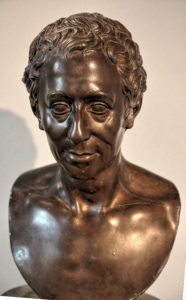
Die bronzierte Gipsb¸ste Winckelmanns geht auf jene postume Portraitvariante von Friedrich Wilhelm Doell zur¸ck, die von Louis Valadier in Bronze gegossen und 1778 an die Kassler Akademie ¸bersandt wurde (heute Kassel, Staatliche Kunstsammlungen). Unter Anleitung von Mengs und Reiffenstein schuf Doell 1777 die Variante, die Winckelmann mit dezenten Altersz¸gen und sorgsam gelegter Lockenfrisur auf idealisierte Weise darstellt. Markant an diesem Typus ist der nach vorn gereckte Kopf. Die Schultern und Brust anschneidende B¸stenform in quot; heroischer Nacktheit & quot; geht auf Vorbilder antiker rˆmischer Portraits zur¸ck und unterstreicht die postume Heroisierung Winckelmanns
F. W. Doell, Johann Joachim Winckelmann
Bronze bust cast, 1777/78 by Louis Valadier after Doells marble bust, H 48.2 cm, F 446
Museum Hessen Kassel (www.museum-kassel.de)
Johann Joachim Winckelmann
Winckelmann’s bronze plaster bows go back to the post-portrait version of Friedrich Wilhelm Doell, cast in bronze by Louis Valadier and sent to the Kassler Academy in 1778 (today Kassel, Staatliche Kunstsammlungen). Under the guidance of Mengs and Reiffenstein, Doell created the variant in 1777, which Winckelmann depicted in an idealized way with decent age moves and carefully laid curls. This type is characterized by the forward head. The shoulders and chest of the incisive busts in “heroic nakedness” go back to models of ancient Roman portraits and underscores Winckelmann’s post-heroization. The Stendaler Gipsbüste also includes a 1.25 m high base in green colored marble (Verde antico).
The “Kandelaber” Flammen Schüssel auf Engel Köpfe
flames bowl on angel heads created by Prof. Friedrich Wilhelm Döll is intended to symbolize the emanation of the Christian faith over Thuringia and the unity of the Lutheran, Reformed and Catholic Church. The construction project was led by the master builder Pörsch and Hofmaurermeister Sahlender led the construction works. The nine-meter-high “Candelaber” was inaugurated on September 1, 1811, with a large ceremony in front of about 5,000 guests and with the participation of political and spiritual greats. (Drawing)
Around 724, Boniface was to erect the first church of Thuringia (a small chapel of baptism) consecrated to Saint John, on the site of the old or Johannesberg near Altenberg, on the site of an old pagan sacrificial site. Here, children were baptized and the dead of the surrounding places were buried at the Bergfriedhof.
Count Ludwig with the bar (the patriarch of the later Landgraves of Thuringia from the house of the Ludovingians) enlarged the church in 1042 and solemnly inaugurated in 1042 by Archbishop Bardo of Mainz. In this church his son, Ludwig the Springer, the later builder of the Wartburg, was said to have been baptized. Until 1712 this church was used for worship.
Since, however, it became too small and dilapidated in time, the Immanuelskirche was erected between Altenberg and Catterfeld, and the old St. John church fell into disrepair. Around 1800, the last walls and grave mounds disappeared on the mountain. “But when the last walls had been ruthlessly torn down, the sculptor Nikolaus Brückner donated 20 florins on his deathbed, so that at least one stone would be the strange place where he himself was a boy Had prayed.
This piety of the simple countryman spoke so much to so many hearts, that soon a sum of 800 talers was used, which was used to erect the still existing “Winfriedsäule”. On 1 September 1811, the monument – the Kandelaber – was inaugurated. The Gotha sculptor FW Döll made the monument of sandstone in the form of a huge medieval chandelier resting on 8 spheres. Above, he carries a fire-pan, supported by angel heads, from which a three-part flame blazes-the symbol of the Holy Trinity.

The Flames Bowl On Angel Heads – Friedrich Wilhelm Döll – Symbolize The Emanation Of The Christian Faith Over Thuringia Unity Of Lutheran Reformed and Catholic Church
Below text on Bernini, Winckelmann, and Falconet taken from:
The above text on Bernini, Winckelmann, and Falconet taken from:
The sculpture collection Residenzschloss of the Counts of Schwarzburg-Rudolstadt the Kunst- und Wunderkammern, the first one emerged in the 18th century
THE PLASTIC COLLECTION Starting from the Kunst- und Wunderkammern, the first one emerged in the 18th-century Plastic collections. In the Residenzschloss of the Counts of Schwarzburg-Rudolstadt was Already before 1733 the rarities cabinet dissolved and the art objects found in the Private rooms or in special collection cabinets. However, a separate for Plastics has so far been demonstrable. Individual statues, mostly from Plaster, were predominantly in the private rooms. For example, The estate of Princess Anna Sophie (1670-1728) from 1729 in one Alabaster made various, not exactly described statues as well Single “heads of white plaster”. The same is true for her husband, Ludwig Friedrich I (1667-1718). The importance of individual sculptures also proves Inventory note from the year 1733. At that time were in a chamber on the ground “6 small statues of Gipps” turned off. The production of sculptures took place accordingly According to the aesthetic and the content of the rooms Claims of the respective princely family members. Ludwig Günther II of Schwarzburg-Rudolstadt (1708- 1790) around the collection. He acquired casts of ancient and contemporary sculptures, The library, and the garden of his Apanage seat (Ludwigsburg). With The takeover of the government business in 1767 began Prince Ludwig Günther II. With the expansion of rooms in the Heidecksburg, in order to specifically targeted collections. A Cabinet reserved for sculptures was still not among them. The Casts acquired by him served, for the most part, the decoration of the library, the Painting collection or gardens. Especially with the equipment of the library were New purchases of portraits of antique and contemporary personalities for the Conscious association with literary genres (eg Aesculap graced the holdings of the Medicine and medicine, Laokoon and Venus crowned the shelf for antiquity and The fine arts). The Cabinets established by Ludwig Günther II existed for only 21 years – From 1778 to 1799. But the collection of works of art, especially for antique ones Casts, had passed to his Enkelsohn, Ludwig Friedrich II (1767-1807). Both Stood at that time with the most important works of art for Thuringia by Martin Gottlieb Klauer (1742-1801) in Weimar and Carl Christian Heinrich Rost (1742-1798) in Leipzig in Contact. They also sent their court artists to study at other residencies or Commissioned them to purchase works of art. This is how Johann Friedrich Franz Kotta (1758-1821), who collaborated with artists from the Thuringian courts in Weimar, Gotha, and Meiningen, the purchase of casts after the antique as well as of Busts of contemporary personalities. But also Ludwig Friedrich II Without exception, sculptures. Just like his grandfather, he integrated Them in the collection of paintings, houses, and gardens. The courtyards of Anhalt-Dessau and Hesse-Homburg. In addition, Ludwig Friedrich II, an Educational idea of his time, the public drawing school founded in 1795 Statues and busts for instruction. The rulers following him renounced this form of self-presentation. Your Collections no longer had the flagship effect of the 18th century. The library Was now predominantly populated with busts of aristocratic persons, mostly kinship References. Portrait sculptures of the individual family members decorated the private rooms. The sculptors of other courtyards were usually commissioned to produce them Example: Leopold Friedrich Doell from Gotha or Franz Woltreck from Dessau. The antique Casts were still standing in the gardens or were in the entrance halls of the Castle. Until 1918 there seemed to have been no serious changes, first A year later the main part came to the “Fürst-Günther-Stiftung”. With their During the early twenties, the director of the former Schlossmuseum Dr. Berthold Rein. This first caused a “repair” and cleaning of the Casts. At the same time, Rein arranged the “rental” of sculptures to citizens of this city,
Such as to the owner of the grasping company Karl Dietz. In addition to this On the other hand, he provided fragmentation for the collection of the stocks from the Various institutions of the city, which in individual Schauräumen the Heidecksburg As well. This state lasted until 1945. A survey and inventory of the inventory Began only in 1963. In addition, the collection policy was accentuated differently In the early 1960s, purchases of works by contemporary artists took place. In the course of the reconstruction of the Schlossbibliothek, Restoration and erection of some portraits bought by 1800 Original location. Ten years later, the exhibition “Die Classical sculpture art in Thuringia “for the restoration of sculptures of the epoch. Since then, they have returned to their living and business environment in their historically assured environment As well as in the stairwell. Doreen Winker
The painter son of the sculptor Friedrich W. E. Döll
Ludwig (Friedrich Ludwig Theodor) Doell
– born in 1789 in Gotha in the family of the sculptor Friedrich Wilhelm Eugen Doell. Initially trained by his father and by the royal painter Kuehner in Gotha, in 1805, he became a pupil of Goethe’s friend Heinrich Meyer in Weimar. From 1806, he was a pupil of the famous Neoclassical portraitist Joseph Grassi at the Academy of Dresden. Together with Grassi, Doell made two long study trips to Italy: in 1809-1811 and in 1817-1821.
During these stays, he was mainly copying Old Masters, but also painted his own compositions. Between 1807 and 1822, Doell was sponsored by Duke August of Saxe-Gotha-Altenburg, who regularly gave him numerous portrait commissions. In 1812, Doell was appointed the director of drawing school in Altenburg, and along with this occupation had a close connection to Gotha court during the following years.
His painting “Die Albanerin”, created in 1818 and depicting an Italian woman from Albano in South Italy (in reality a portrait of Barbaruccia Pizzicaria, currently in Lindenau museum, Altenburg) brought him great success. This work was so popular that Doell made nine (!) replicas of it. One of those replicas is exactly the third above mentioned LD-painting from Hannover. It was acquired by “Alte Kunst” gallery in Vienna.
The success of “Die Albanerin” brought Doell many portrait commissions from the members of high society. Very soon he became the leading portraitist of his region. In 1824 he was appointed a professor and in 1826 finally settled down in Altenburg. In this town, just chosen as royal residence, he has risen to the leading painter of late classicism and biedermeier. His house became a meeting place for friends of art and a training place for young artists. In 1830-1834 Doell was a director of Kunst- und Handwerksverein (Society of Arts and Crafts) in Altenburg. In 1838, after the death of his teacher Grassi, he inherited the latter’s unfinished paintings and studies, a part of which he then brought to completed compositions.
Works of this artist, especially portraits, are part of private collections in Altenburg and Gotha. Many of them are displayed in museums of Altenburg, Gotha, Halle, Weimar, etc.
Further research led us to the magazine “Am häuslichen Herd. Sonntagsblatt der Altenburger Zeitung” , in its issue n° 18 of Sunday, 28th April 1895 a detailed biography of our painter was published. In this biography was discovered the “Pandora” was painted in Autumn 1817 in Rome.
Ernst Friedrich August Rietschel,
born 15 December 1804 in Pulsnitz, died 21 February 1861 in Dresden, sculptor of the Goethe-Schiller Monument Weimar Casting by Ferdinand von Miller the casting works in Munich
[
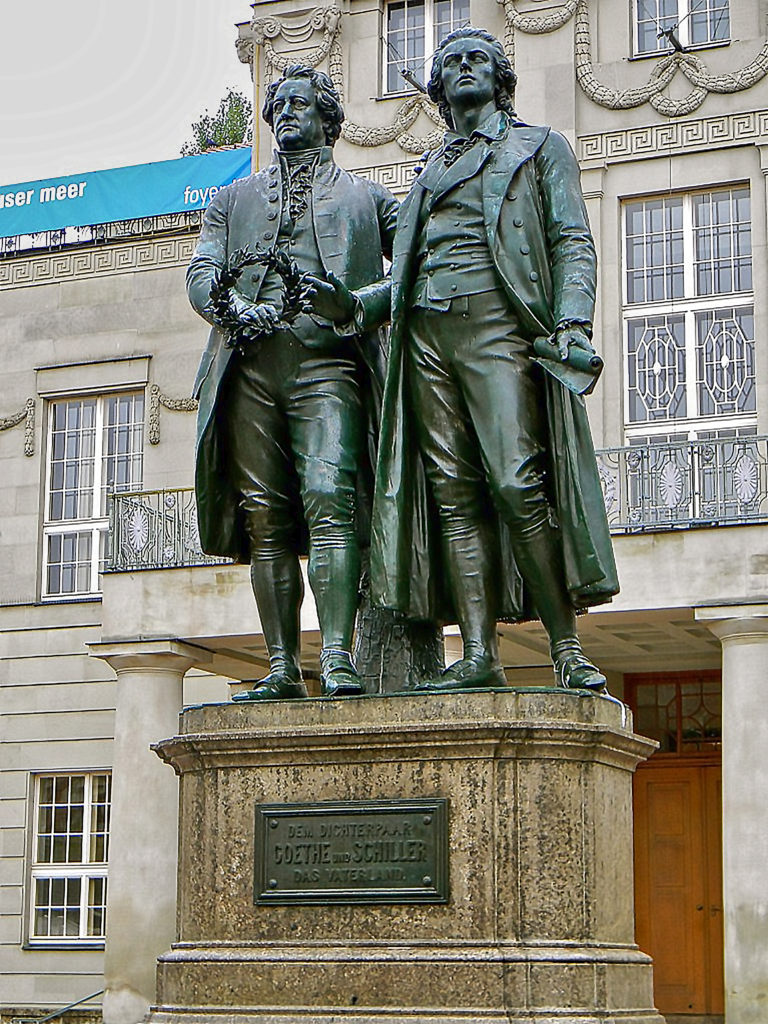
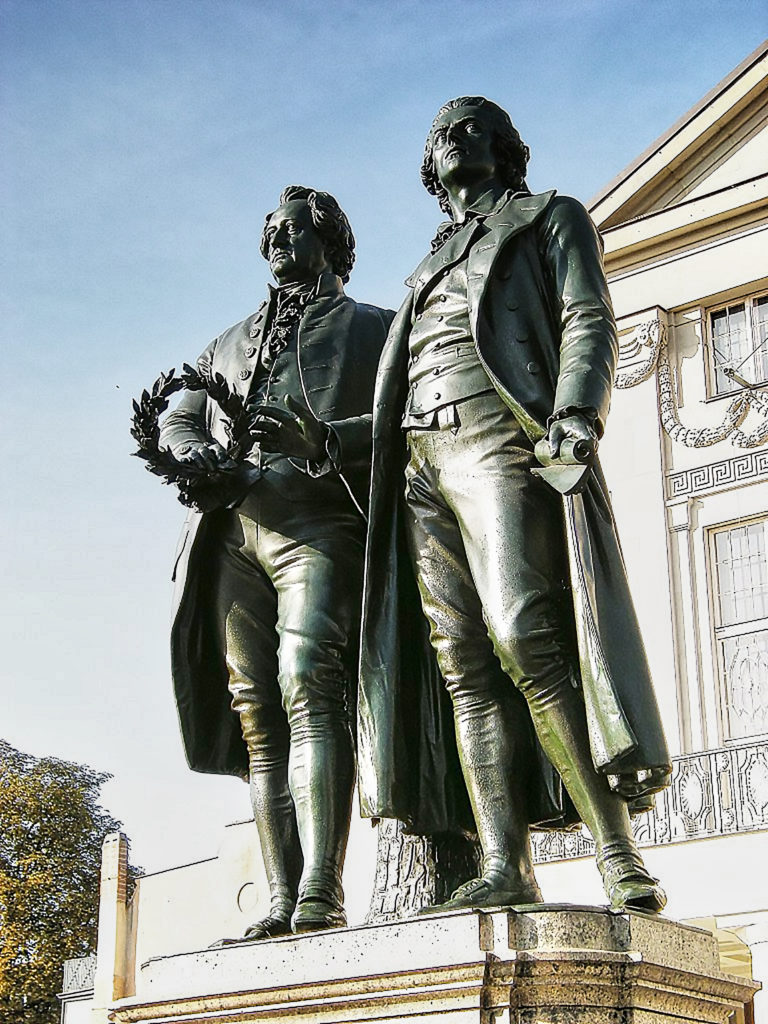

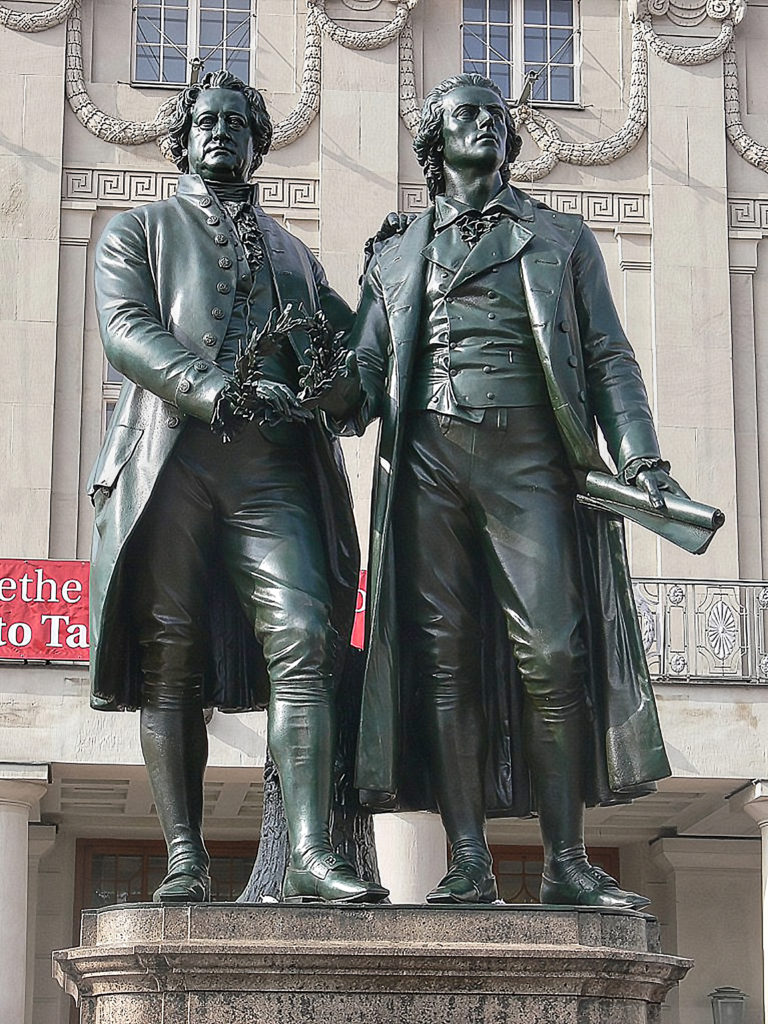
1841 Das erste Königliche Hoftheater von Gottfried Semper, das in den Jahren 1838 bis 1841 entstand, wird am 12. April mit Carl Maria von Webers »Jubelouvertüre« und Johann Wolfgang von Goethes »Torquato – picture 1 & 2; remaining pictures of the Dresden Hochschule für Bildende Kuenste, Dresden, Denkmal Gottfried Semper vor Lipsiusbau der Kunstakademie, – Athene zwischen Prometheus und Psyche, darunter Apollon-Kopf (bzw. Genius der Kunst) über dem Portikus des Kunstausstellungsgebäudes (Lipsiusbau) in Dresden von Johannes Schilling, the sculptors for the “Dresden Hochschule für Bildende Kuenste” were Johannes Schilling und Robert Henze. Auch weitere Professoren wie Heinrich Epler und Hermann Hultzsch. Robert Henze, sculptor of – Fama, Dresden_Hochschule_für_Bildende_Kuenste
Dresden, Denkmal Gottfried Semper vor Lipsiusbau der Kunstakademie
The Dresden sculptor Ernst Rietschel was a student of Franz Seraph Johann Nepomuk Pettrich (Pettrich was a student of Bertel Thorvaldsen in Rome) at the Royal Saxon Academy of Art, Dresden, (Hochschule für Bildende Künste Dresden), and later under Christian Daniel Rauch in Berlin. From Rauch in the line of influence from Goethe, Winckelmann, and the Classicism of the Thüringen Weimar group. Rietschal visited the elder Goethe on several occasions. Rietschel worked along with the important architect Gottfried Semper. Ferdinand von Miller was an important sculptor in Munich apart from his foundry works.

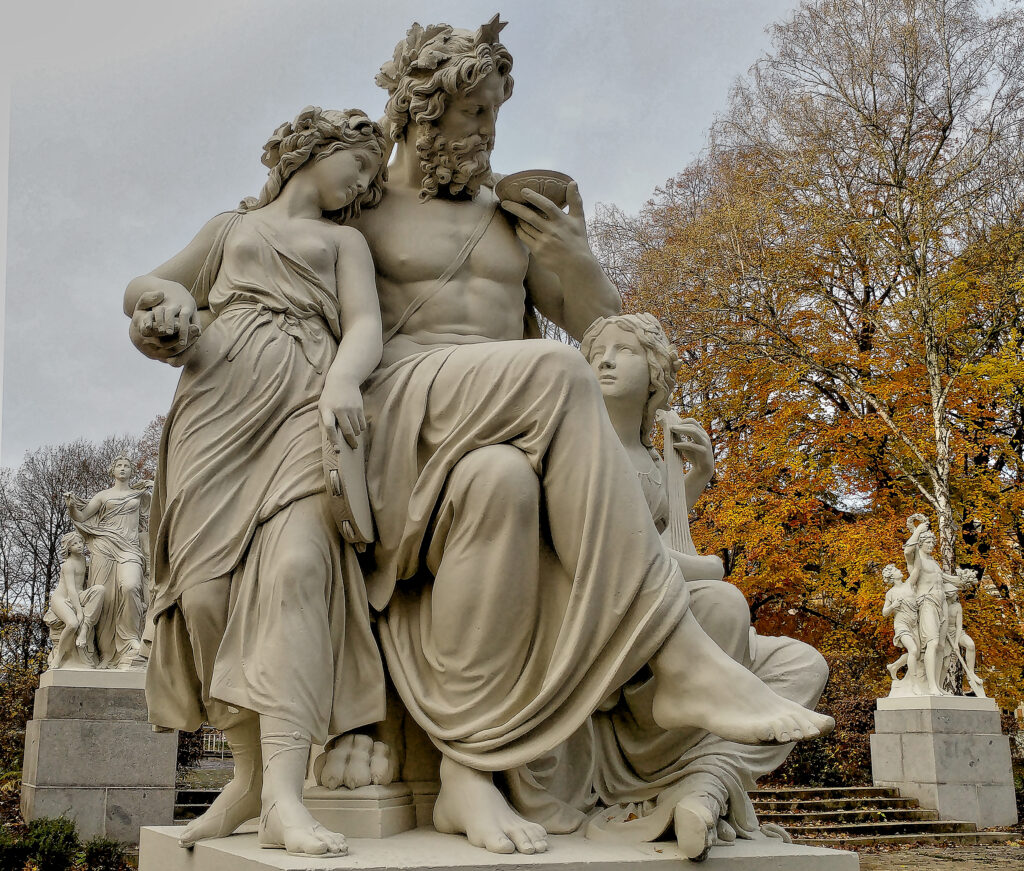
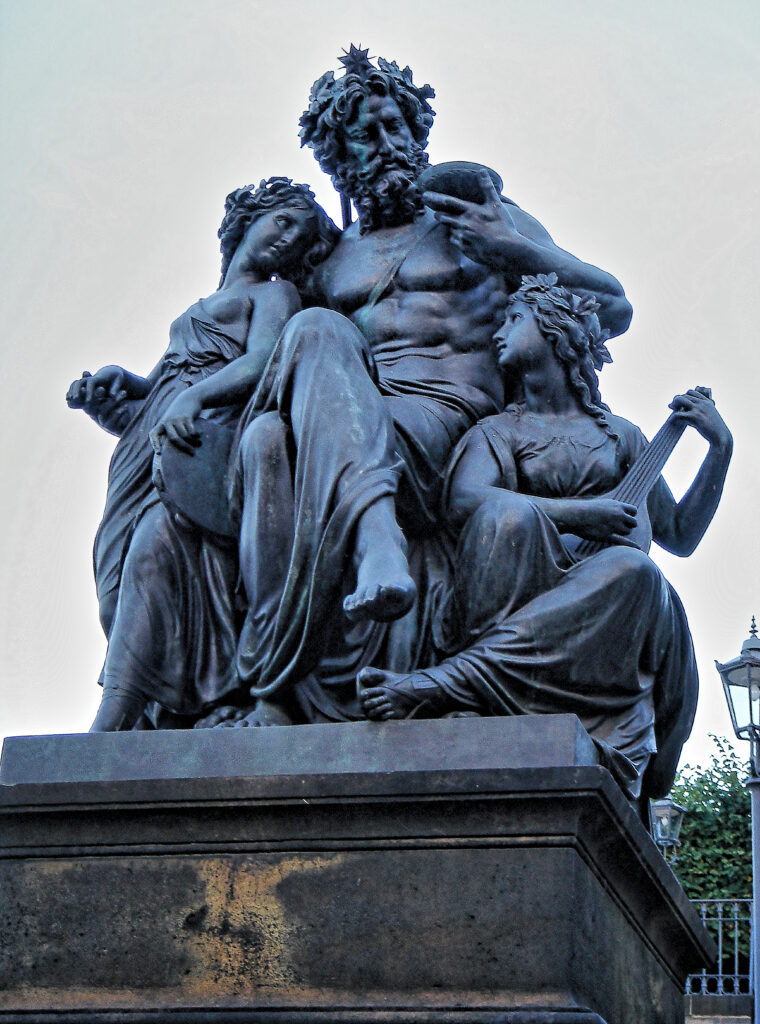
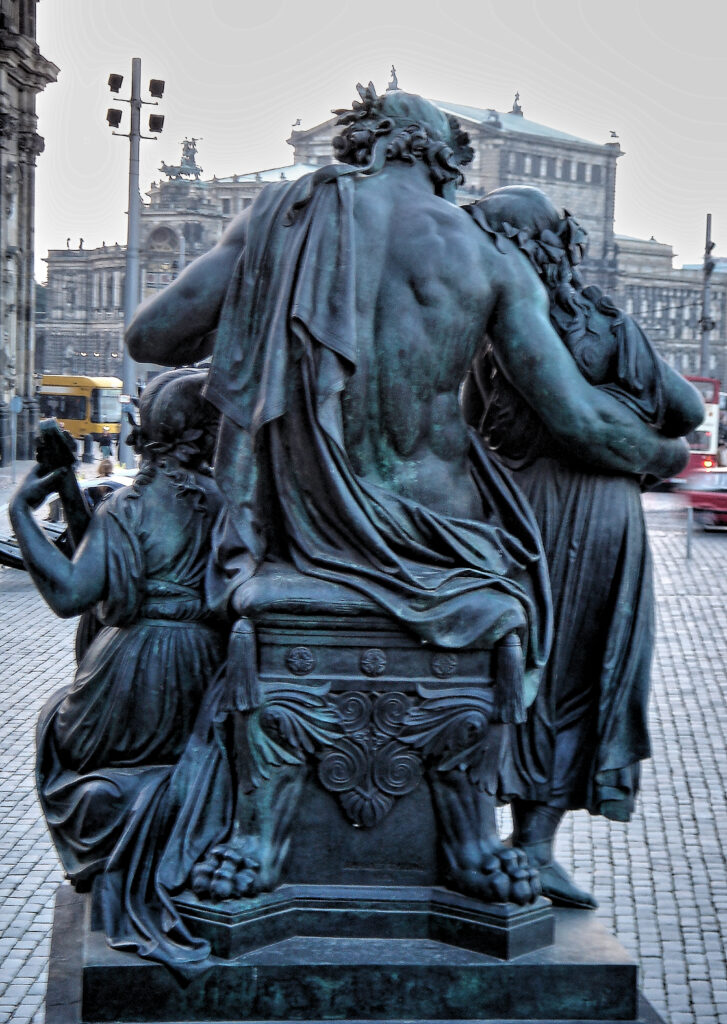
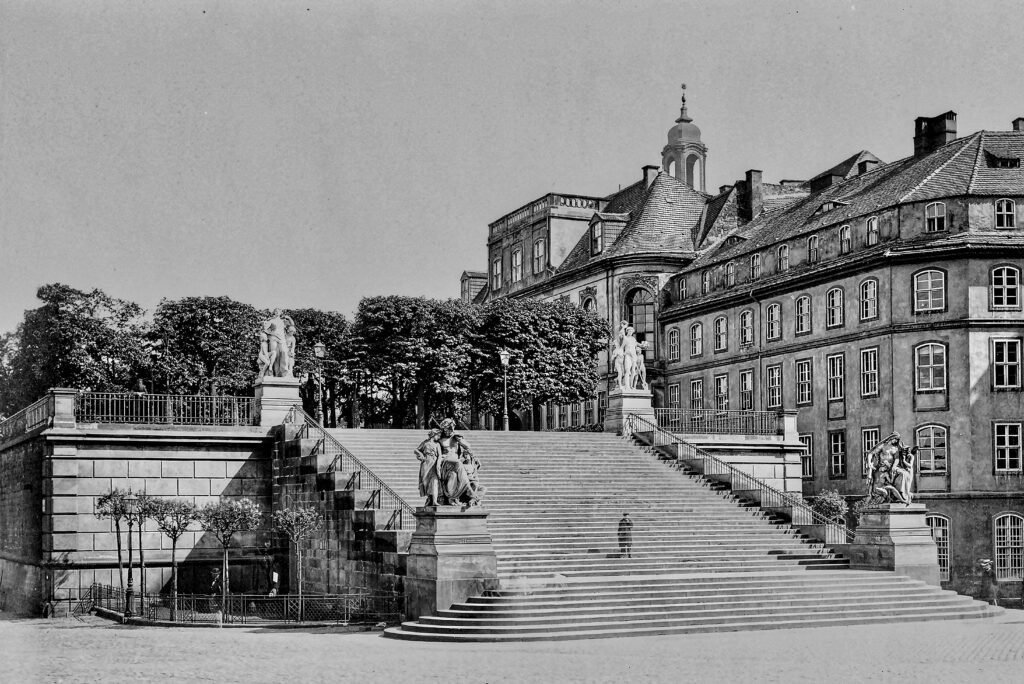
Ernst Friedrich August Rietschel Goethe Schiller Monument Weimar Thüringen
Julius Caesar Thaeter (January 7, 1804 in Dresden, 14 November 1870 in Munich) was a German engraver reproduction.
Thaeter studied at the Dresden Academy (Academy of Fine Arts in Dresden) and in Nuremberg, from 1826 to 1834 his residence was then in Munich (1834-41), Weimar (1841-43) and Dresden (1843-49), where he was an art teacher since 1846 at the Academy. In 1849 he was appointed to the Academy of Fine Arts in Munich, as a professor, but abandoned the position in 1868, and took over the management of the print room.
Thaeter underwent training as an artist, and became a self-taught graphic artist, original, and reproduction. In Munich, he found access to the circle of the Nazarenes (Art), and became the ” Kartonstecher.” Noteworthy are the Stiche (stitch (printing)) by Peter von Cornelius, Wilhelm von Kaulbach, Julius Schnorr von Carolsfeld, Asmus Carstens and Moritz von Schwind.
”
”
Antoine Houdon, – France, b. 1741 Versailles – d. 1828 Paris, sculptor, Diana, Plaster, (LifeSize sculpture), Gotha, Thuringia, Germany
[]
Jean-Antoine HOUDON – Versailles, 1741 – Paris, 1828,
Diana,
Plaster, (LifeSize sculpture), Gotha, Thuringia, Germany
Jean-Antoine HOUDON – Versailles, 1741 – Paris, 1828,
Houdon presented a life-size plaster of Diana in his studio during the 1777 Salon. The finished sculpture was to be executed in marble (Gulbenkian Foundation, Lisbon) for Duke Ernst II of Saxe-Gotha, as compensation for a commission lost by the sculptor. The bronze version is now in the Louvre. The sculpture was acclaimed for its beauty worthy of classical statuary. The impression of swiftness is accentuated by Diana’s slim figure. Yet her unabashed beauty caused a scandal. Diana was habitually portrayed in a short tunic belted at the waist, in the manner of the often-copied Artemis the Huntress (Louvre), a classical marble acquired by Francis I. The goddess’s nudity was deemed acceptable only when she was depicted bathing. The same year as Houdon, Christophe Allegrain showed – also outside the Salon – his buxom Diana, surprised by the huntsman Actaeon while bathing (Louvre). Yet during the Renaissance, the goddess of hunting was often represented in the nude. The Diana the Huntress of the School of Fontainebleau (Louvre) and the large marble group from the Château d’Anet (Louvre) – in which the nude Diana, accompanied by her dogs, reclines, her arms around a stag – are two well-known examples.
‘ Antiquity revisited ‘
Houdon’s wonderfully reconciles the aesthetics of antiquity and the Renaissance. From antiquity, Diana has retained her triumphant nudity, whose elegance and distinction inspires respect rather than temerity. The goddess’s noble, even haughty bearing; serene, idealized face reflecting no emotion; and distant gaze render her impersonal and inaccessible. The elongation of the female body, firm anatomy, and linear purity belong to the Renaissance of the School of Fontainebleau. Her slender body, leaning slightly forward on one foot, gives the statue an ethereal and dynamic allure and affords multiple points of view. It evokes the daring balance of the flying Mercury by Giovanni da Bologna (1529-1608), a Florentine sculptor of Flemish origin who exercised considerable influence on European sculptors. But Houdon’s Diana is also a full-bodied creature of the flesh. Her naked pubis, considered too realistic, was filled in and flattened in 1829.
‘ A technical tour-de-force ‘
The glory of the great masters of French sculpture (Girardon, Coysevox, Lemoyne, Bouchardon, Pigalle) rests on their bronze statuary, but they seem to have known little about the technical aspects of casting. Houdon, who had a passion for the art of casting, cast two large bronzes of Diana himself at the Roule foundry in Paris: an eight-piece one in 1782 (San Marino, California) and a five-piece one in 1790 (the statue now in the Louvre was purchased at auction by Charles X after the sculptor’s death in 1828). – Jean-Antoine Houdon studied in Paris under such sculptors as Jean-Baptiste Lemoyne and Jean-Baptiste Pigalle. As a winner of the Prix de Rome, he worked in Rome from 1764 to 1768. There he was influenced by ancient artifacts, including those recently unearthed in Herculaneum and Pompeii, and works of Renaissance masters, especially Michelangelo. He created his important anatomical study of a standing man, known as the Écorché, or “flayed” figure, which later was replicated and used in most art schools. The Écorché displays a continuing characteristic of his art: classicism combined with a merciless realism. Skilled in marble, bronze, plaster, and clay, Houdon became a member of the Académie Royale in 1771 and a professor in 1778. He made his reputation with his portraits, producing a veritable “Who’s Who” of his era’s royalty, artists, and philosophers. Patrons appreciated his ability to give marble the effect of living flesh as well as his knack for capturing his sitter’s personality. In 1785, at the request of Thomas Jefferson and Benjamin Franklin, Houdon crossed the Atlantic. He spent fourteen days at Mount Vernon executing a statue of George Washington. After narrowly escaping imprisonment during the French Revolution, Houdon returned to favor under Napoleon Bonaparte and finally retired in 1814. Jean Antoine Houdon, – France, b. 1741 Versailles – d. 1828 Paris, sculptor, Diana, Plaster, (LifeSize sculpture), Gotha, Thuringia, Germany Jean-Antoine HOUDON – Versailles, 1741 – Paris, 1828 Diane chasseresse 1790Diana, Plaster, (LifeSize sculpture), Gotha, Thuringia, Germany
“All the text above here on this Post of J. A. Houdon is from the Getty Museum exhibition”
Stuttgart Schillerplatz Schiller von Bertel Thorvaldsen 1839
Museum Der Natur, Gotha, Thüringen – Lion
[contact-form-7 id=”1819″ title=”Contact form 1″]
